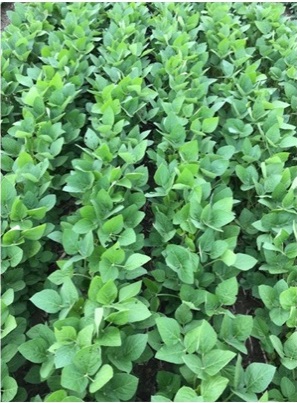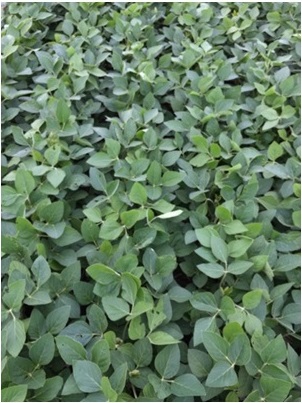Soybeans have an additional need for sulfur not present in corn, wheat
By Shaun Casteel
Purdue University Extension Soybean Specialist

Sulfur (S) is a macro-nutrient that is needed in large quantities for all crops – including soybeans.
Soybeans take up .35 pounds of S per bushel, so 50- to 75-bushel soybeans would need 17.5 to 26 pounds of S per acre. A little more than half of this S is removed in the grain – largely in amino acids of the protein – thus 9 to 13.5 pounds of S per acre is removed from the field in the grain.
Soybeans have an additional need for S that is not present in corn and wheat. Sulfur is needed as a co-factor for root-nodule formation by Bradyrhizobium japonicum (see Figure 1). A limited S supply can restrict biological nitrogen (N) fixation of soybean.
This combination of a low supply of S and N, via poor nodulation, can restrict the yield from 5- to 20-bushels per acre, and the quality of soybean grain (i.e., protein) in many fields.
Application of S
Atmospheric deposition of S, mineralization of organic matter and plant residue, and fertilizer applications are the primary sources of S. In Indiana, annual atmospheric deposition has declined from nearly 20 pounds of S per acre in the 2000s to now less than 5 pounds of S per acre. Coarse-textured soils with low organic matter (less than 2 percent) have traditionally been more deficient in S than heavy-textured soils with more organic matter.
Approximately 3 pounds of S per acre is mineralized annually for every percentage point of soil organic matter. Thus, a soil with 3 percent organic matter would have about 9 pounds of S per acre mineralized plus 4 pounds of S per acre deposited from the atmosphere to total 13 pounds of S per acre, which is still half of the 26 pounds of S taken up by a 75-bushel soybean crop.


This back-of-the-envelope calculation does not mean every field needs S fertilizer applied, but it certainly should raise awareness for you to test for yourself. Current soil nutrient analyses can provide S concentration, but the correlation to crop need and yield response is unreliable due to the timing of the soil analyses and the mobility of S in the soil. Sulfate movement is somewhat similar to nitrate leaching.
Leaf nutrient analyses of the most recent mature leaf can provide a snapshot that S may be an issue when concentrations are below .25 percent S or “close” to it. Another indicator of S issues is the ratio of N to S in the leaf tissue. As this level approaches and exceeds 18:1 (18 parts N to 1 part S), soybeans will be more responsive to S application. Ultimately, we need to allow soybeans to be the S integrator of atmospheric deposition, soil supply and management interactions.
We have documented sizable yield gain, 7- to 22-bushels per acre, improvement in leaf nutrition and positive plant growth responses (e.g., nodulation and N fixation, leaf retention, seed protein) following targeted S fertilizer applications. Soybean responsiveness to S applications can be categorized into true S deficiency and situationally deficient in S.
The first category of true S deficiency is based on the soil supply and lack of deposition (i.e., the traditional fields that are coarse-textured with low organic matter). Soybeans in these fields are the ones that respond to S year in and year out no matter the production practices. The second category is where the soybeans are situationally deficient in S based on the combinations of field characteristics and management such as planting date, tillage and cover crop inclusion.
Foundations in higher yields
Timely planting of soybeans has provided solid foundations in high yields. In fact, Indiana has repeatedly broken state record yields in 2018, 2020, 2021 and 2023 as the planting progress was earlier than the 5-year average. Indiana’s planting of soybean crops has shifted from approximately 14 days after corn from 2010 to 2017 to approximately five days in 2018 to 2021. Now it is usually within 1.5 days of corn.
Many farmers are even planting soybeans ahead of corn. Soybeans often sit in the ground for weeks on end due to cool and sometimes wet conditions. These cool conditions, approximately 50-degrees F., also slow microbial activity. As a result, mineralization of organic matter and breakdown of plant residue to supply N and S.
The limited mineralization has provided challenges, but also opportunities to overcome and be even more productive. As an example, my timely planting of soybeans on a prairie soil, approximately 4 percent organic matter, has averaged an 8- to 11-bushels per acre response to S fertilizer (e.g., ammonium sulfate, pelletized gypsum, ammonium thiosulfate) applied PRE at 20 pounds of S per acre during a 5-year period.
Conversely, soybeans planted later in the same soil that was warmer did not respond to S fertilizer.
The situational response to S was even more dramatic in 2023. Soybeans planted on April 18 went from 77- to 99-bushels per acre with the addition of ammonium sulfate or pelletized gypsum (see Figure 3). A May 12 planting displayed a similar response from 75- to 90-bushels per acre, but the June 7 planting displayed no benefit of S fertilizer.
If you have not explored S on your soybean crops, I suggest applying strips of S fertilizer that is soluble (e.g., ammonium sulfate, pelletized gypsum, ammonium thiosulfate) between 15- to 25-pounds of S per arec to determine if you have fields or production practices that are responsive to boosting nodulation and N fixation. Applications can be applied mid-March through planting with higher rates the earlier you apply the S fertilizer.
Posted: March 23, 2024
Category: Indiana Corn and Soybean Post - March 2024, ISA, News




